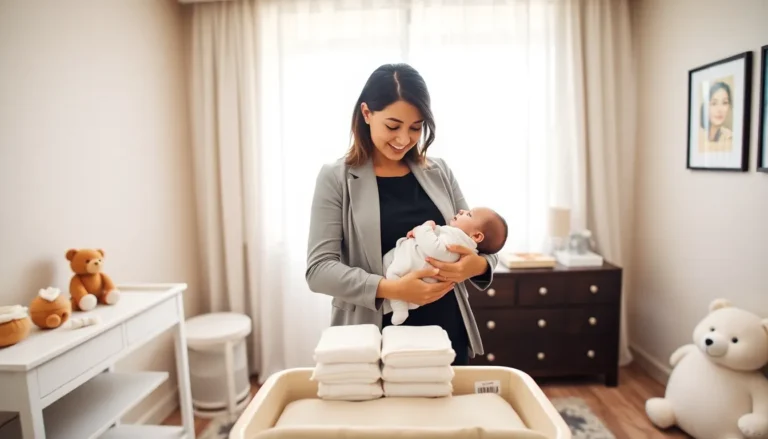Table of Contents
ToggleIn a world where attention spans are shorter than a TikTok video, boosting ChatGPT’s memory might just be the superhero move you didn’t know you needed. Imagine having a virtual assistant that remembers your preferences, past conversations, and even your favorite cat memes. It’s like having a digital sidekick who’s always got your back, minus the spandex suit.
Understanding ChatGPT Memory
ChatGPT memory refers to its ability to retain and recall information from past interactions. This capability allows it to maintain context over extended conversations. Effective memory management plays a crucial role in personalizing user experiences.
Memory storage includes various elements, such as user preferences, conversation history, and specific requests. When more data is available, it becomes easier for ChatGPT to tailor responses that align with individual needs. Users often desire seamless interactions where past discussions inform future exchanges.
Considerations for managing memory involve identifying significant patterns across conversations. Recognizing frequently mentioned topics or particular interests enhances relevance in responses. This memory utilization fosters a connection that meets user expectations.
Techniques for increasing memory capacity may involve improving data retention mechanisms. By evaluating the effectiveness of current methods, developers can implement innovative solutions. Continuous updates and refinements can lead to superior user interactions.
Strategically adapting memory can elevate the overall functionality of ChatGPT. Users benefit when the system remembers vital details, creating an assistant that feels intuitive and responsive. As memory evolves, so too does the potential for enhanced engagement and satisfaction in interactions.
Ultimately, understanding the intricacies of ChatGPT memory is essential for optimizing its performance. Balancing memory capabilities with user expectations results in a more effective virtual assistant.
Importance of Increasing ChatGPT Memory

Increasing ChatGPT’s memory plays a vital role in enhancing user interactions. Memory enhancements lead to more personalized and engaging experiences for users.
Enhanced User Experience
Personalization improves user satisfaction significantly. When ChatGPT recalls user preferences, it can provide tailored responses that resonate better with individual needs. Instead of repeating questions, it anticipates inquiries based on prior interactions. A digital assistant that remembers past conversations feels more intuitive and reliable. Users appreciate a seamless connection that evolves over time. Feedback from users indicates that curated interactions boost their overall experience.
Improved Context Retention
Maintaining context across multiple exchanges is essential for effective communication. Enhanced memory enables ChatGPT to track ongoing topics and remember crucial details from previous conversations. This capability reduces misunderstandings and creates a smoother dialogue flow. When users know that ChatGPT remembers their past input, interactions feel more relevant and coherent. Consistent context retention fosters trust and encourages users to engage more frequently, enhancing the overall interaction quality.
Techniques to Increase ChatGPT Memory
Improving ChatGPT’s memory can significantly enhance user interactions. Several techniques can help accomplish this goal.
Model Fine-Tuning
Adjusting model parameters plays a crucial role in memory enhancement. Tailoring algorithms to user data leads to better retention of individual preferences. By training on diverse datasets, ChatGPT can learn specific patterns relevant to user interactions. Continuous updates with feedback loops further refine its responses. Customizing for unique use cases allows for a more personalized virtual assistant experience, which increases user satisfaction.
Data Management Strategies
Effective data management strategies enhance memory retention significantly. Storing conversational context helps maintain continuity in discussions. Categorizing past interactions enables tailored responses that align with user interests. Regular audits of memory data ensure relevance and accuracy, preventing outdated information from arising in conversations. Prioritizing essential details allows ChatGPT to anticipate user inquiries accurately, fostering a more engaging interaction based on historical context.
Limitations and Challenges
Increasing ChatGPT’s memory comes with specific limitations and challenges. Potential privacy concerns arise when storing user data for memory enhancement. Securing sensitive information necessitates robust data protection measures.
Technical constraints also impact memory capacity. Current models may experience difficulty retaining extensive data across numerous conversations. This limitation affects the ability to maintain context and relevance in dialogues over time.
User preferences can differ significantly. Some users appreciate a more personalized experience, while others may prefer less data retention. Striking a balance between memory retention and user control poses a challenge for developers.
Training memory models requires extensive resources. Significant amounts of annotated data and computational power are necessary to ensure effective memory management. These resource demands can limit the scalability of enhancements.
Maintaining accuracy in data retrieval poses another challenge. Misinterpreting or incorrectly recalling prior interactions can lead to user frustration. Developing effective algorithms for accurate retrieval remains an ongoing area of improvement.
User engagement can fluctuate based on memory capabilities. When memory retention aligns with user requests, it enhances the interaction. However, if interactions feel disjointed due to memory lapses, users may disengage.
Continuous evaluation is vital. Regular audits and updates ensure relevance and accuracy of memory data. Effective memory management strategies contribute to minimizing these challenges and optimizing user experiences.
Enhancing ChatGPT’s memory capabilities holds significant promise for creating more personalized and effective user interactions. By focusing on memory management and data retention techniques, developers can improve the model’s ability to recall user preferences and past conversations.
However, it’s crucial to navigate the challenges that come with increased memory, such as privacy concerns and technical limitations. Striking the right balance between personalization and data retention will ultimately determine the success of these enhancements.
As advancements continue, the goal remains clear: to develop a virtual assistant that not only understands but anticipates user needs, fostering a more engaging and satisfying experience.








